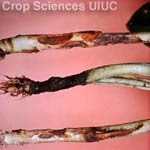Rhizoctonia Root Rot

Symptoms:
- Rhizoctonia root rot is a widespread and common seedling and root-rotting disease of soybean.
- Damage prior to emergence is common but difficult to identify.
- In seedlings and older plants, a reddish-brown sunken lesion is a characteristic symptom of Rhizoctonia infection.
- Fusarium solani, which causes seedling rot, is commonly associated with Rhizoctonia infections. It is not possible to identify dual infections in the field.
- The infections can be superficial and cause no noticeable damage to plants, or they can girdle the stem and kill or stunt plants.
- Seedlings or older plants may be stunted and may wilt from a firm, dry, brown to reddish brown decay or sunken lesion on the root and stem below or near the soil line.
Pathogen Involved:
- Rhizoctonia solani (a soilborne fungus).
- It has a wide host range that may include corn, alfalfa, and soybean.
Time of Occurrence:
- Primarily in early to mid summer, but can occur all season.
Conditions Favoring Disease:
- High soil moisture - but not saturated.
- Warm soil temperatures.
- Herbicide injury.
- Soil types with high amounts of organic matter.
- Delayed emergence.
Disease Management:
- Crop rotation and some seed treatments can reduce damping-off and root rot.
- Tillage may be of value where disease was severe.
- Encourage seedling health with good agronomic practices and avoid herbicide stress.